These are the days the sun beats down 24 hours a day on the Pole, and it actually gains more heat than it loses. The heat should add up until warm fronts come down from the north, but this never happens. A little thing called the Arctic Ocean gets in the way. Melting its ice sucks up all the extra heat, and even in July cold fronts come down from the north.
The intense sunshine turns out to be rather feeble, compared to the ice, for the sunshine has only two months to do its stuff, but the ice had ten months to not only form, but to chill to a degree wherein it can be twenty or thirty degrees below freezing, and it can take a long time simply warming the ice up to the freezing point. Then, once you get to that magic point, the phase-change between solid H2O and liguid H20 involves all sorts of heat just plain vanishing, as it becomes “latent”, in the fluid molecules of water. By the time the sunshine has really started its melting its allotted time of two months is over, and freezing starts.
In the end it turns out the breaking up of sea-ice is not a top-down matter, but rather bottom-up, due to warm waters under the ice, or else a ice-transport matter, due to the ice being transported south to warmer climes. In other words, breaking up the sea-ice is not easy, for either you have to transport a warm sea north beneath it, or you have to transport it down to the warm sea.
On these posts we only deal with the superficial, for we lack access to what is going on under the ice. It is down deep that the important shifts in currents occur, but we are merely passengers bobbing on top. However even so we are able to refute a lot of Global Warming theory, for it is even more superficial than we are.
We focus on the progress of “Faboo”, which is our name for the North Pole Camera. This year it is behind schedule, heading south. Yesterday it only crossed 2.01 miles, nudging south and ending at 86.626°N, 3.901°W. (Westward movement halted at 3.931°W, at 1500z, and now we creep east.) Winds were light, and even calm at 0300z. During this calm we created a mico-climate, and temperature spiked up to +4.6°C, and then plummeted to +1.5°C at 0600z, as the slight winds again blew. These mirco-climates are due to the objects sitting around absorbing sunlight, which Faboo demonstrates by showing us that buoys sit in pools and snow-stakes in dents, which demonstrates the darker objects catch the heat of the sunlight, and may inflate temperature readings.
The best example of transport we have is O-buoy 9, whose movement has recently been arrested, as we now are nudged back north and west. Temperatures have dripped back nearly to freezing.
Currently high pressure rules the Pole, as the low pressure “Baltfil” is repulsed back towards Siberia.
SUNDAY MORNING UPDATE
Once again the Mass balance buoys are taking the weekend off, so this report will be short.
The morning maps show the high pressure weakening slightly on the Pacific side of the Pole, and being nudged slightly towards Svalbard, so the flow at the north entrance of Fram Strait may even be swinging around to the south. The high pressure has sucked some of the Pacific chill towards the Pole, but the sub-freezing temperatures persist towards East Siberia. (This continues to surprise me, for I expected warmer-than-normal readings towards the Pacific, due to “warm” PDO.)
Faboo’s camera shows the melt-water pool I dubbed Lake Faboo is shrinking again, after filling slightly during yesterdays thaw.
Down towards the northeast corner of Greenland O-buoy 9 is hesitating at the brink of doom, backing away west slighty rather than plunging southeast into Fram Strait. temperatures have dipped below freezing, and winds slacked off to below 5 mph. Across the Pole towards Bering Strait, on the border between Chukchi and Beaufort Seas, O-buoy 12 continues to make a liar out of me. I predicted it would be the first camera to show ice breaking up, and instead it remains solid, and has shown us snows and sub-freezing temperatures. Currently we’ve made it back to thawing, and “Lake Chukchi” to the left seems to be slightly fuller.
Across the Pole towards Bering Strait, on the border between Chukchi and Beaufort Seas, O-buoy 12 continues to make a liar out of me. I predicted it would be the first camera to show ice breaking up, and instead it remains solid, and has shown us snows and sub-freezing temperatures. Currently we’ve made it back to thawing, and “Lake Chukchi” to the left seems to be slightly fuller. 
Further east in the Beaufort Sea O-buoy 11’s camera continues to slowly tilt as its base thaws, but the thaw has ended for the moment. The lead in the middle distance, just beyond the pressure ridge, had opened but appears to have again clapped shut. The Pole is relatively cloudless, compared to other times, and now is a good day to zoom in with the Google Map to see the actual state of the ice with your own lying eyes. Of interest is the patch of open water O-buoy 9 explores at the northeast corner of Greenland. The ice in the central arctic is more solidly packed than last year, when I described it as “the Pulverized Pole”. The link below will hopefully get you to the google map.
The Pole is relatively cloudless, compared to other times, and now is a good day to zoom in with the Google Map to see the actual state of the ice with your own lying eyes. Of interest is the patch of open water O-buoy 9 explores at the northeast corner of Greenland. The ice in the central arctic is more solidly packed than last year, when I described it as “the Pulverized Pole”. The link below will hopefully get you to the google map.
http://www.arctic.io/explorer/
SUNDAY NIGHT UPDATE
Faboo barely budged today, moving only 1.38 miles southwest in 24 hours, to 86.607°N, 4.005°W. (Yesterday’s eastward bump ended with yesterday’s final report, and all longitudinal motion was to the west.) Winds were very light, and even calm, and when calm decended the temperatures jumped, likely due to the heating of the man-made object sitting on the ice. For example, in the dead calm at 1800z temperatures were +3.3°C, but in the 2 mph wind at the next report they had dropped to +0.6°C.
It truly is glorious weather and a genuine thaw. Lake Faboo again filled and again drained.


 The final picture looks north at the sun near midnight.
The final picture looks north at the sun near midnight.
Far to the south O-buoy 9 sends us a fantastic picture of the headlands of Greenland. It has stopped moving west and is heading east out into open water again.
I expect each picture from O-buoy 9 to be its last, (unless it bobs about as a buoy with no ice, for some of these cameras can float rather well, as O-buoy 7 demonstrated), however it keeps on trucking.
This picture reminds me of the whalers reports from back around 1816 or 1817. As far as they knew this coast of Greenland was inaccessible, but abruptly they were able to chase whales up here, and deemed it remarkable they could see coasts no other captains had seen in living memory.
The other O-buoys are less remarkable, so I’ll skip them until tomorrow. I figure that, if the Mass Balance Buoys can take a vacation, then so can I.
Oh, I should show the DMI maps. They show the chill hanging tough over by Bering Strait, and high pressure hanging tough over the Pole. It looks like Baltfol is giving up its attempt to attack the Pole, and is weakening in the Laptev Sea.
MONDAY MORNING
Have to cover for an employee who called in sick. Just maps and pictures this morning.
MONDAY EVENING UPDATE
It’s been a long, hot day here in New Hampshire, and the cool pictures from the Pole are welcome. The maps surprise me a little, as the high pressure over the Pole abruptly broke in two and weakened, as the remains of Baltfol bulged back toward the Pole. What I suppose is the remains of Lagzipson are moving north from Eastern Russia towards the Kara Sea, and this reinforcement will continue a general push of Ice towards Svalbard. Whether this Pole-to-Atlantic flow can start to involve Faboo, and push it south more speedily, is a possibility, however for the moment Faboo sits in a calm area.
Yesterday Faboo only moved 1.46 miles south and west, to 86.588°N, 4.163°W. Winds remained very light, with calm spells. There was one surprising dip below freezing to -0.2°C at 0300z, but temperatures had rebounded to the day’s high of +2.0° by the next report at 0600z. For the most part the thawing persisted, and the 2100z reading, which ended yesterdays report, was +1.5°C.
Mass Balance data still refuses to download on my computer.
O-buoy 9 continues to hesitate at the brink of taking the plunge down towards Fram Strait. Winds have slacked off to a breathless calm, and temperatures are right at freezing. We have continued east, but drifted north a little. The pictures we relieve continue to be striking. I think the berg we are perched upon is slowly spinning clockwise, for in the first view the headland of Greenland is just slipping off camera to the left, while in the final view we are looking at the sun at midnight, and that is north..

I was so sleepy last night I nearly fell asleep at the computer, just dreaming at the pictures. That was actually my original reason for visiting Faboo, back in the days I just did it without feeling any need to write about what I saw. I liked to just watch and wonder, without worry or warring Alarmists. (Early summer is actually a good time to let your mind drift like the ice, for usually little goes on, and you have to search far afield to find any headlines.) Last night I found myself wondering about fascinating micro-critters that have found an odd niche on our planet to exploit: They live in the ice, in little pockets of super-cooled brine. I was thinking this must be a rough time of year for those creatures, because the ice warms to the freezing point from the top of the ice to the bottom, and most of the brine leaches downward to the sea. And so engrossing was this wondering that I forgot to post the Faboo pictures.
The gorgeous weather continues. Comparing the pictures by opening them to new tabs and then clicking back and forth makes two things clear. First, Lake Faboo continues to slowly shrink, though it is unclear whether the water is draining down through a hole or crack, or leaching down through ice made, by fascinating processes, more like pervious sandstone than impervious limestone. (Hmm. My spell-check says there is no such word as “pervious”.) Second, the snow-stakes are creating their own personal dents in the snow, which shows that the equipment up there does catch the sunshine and create mini-pockets of warmth, especially when it is calm.
YESTERDAY 1224Z (NOONTIME) TODAY 0624Z (MORNING)
TODAY 0624Z (MORNING) The clouds appearing to the right (east) are likely from “Baltfol” which is attempting to bulge towards the Pole from Siberia.
The clouds appearing to the right (east) are likely from “Baltfol” which is attempting to bulge towards the Pole from Siberia.
Despite the fact it is noon at the tops of the above maps, the sub-freezing cold persists over towards Bering Strait, and also along the more cloudy Eurasian coast, where it is afternoon and evening. The sub-freezing temperatures in Baffin Bay likely is associated with the ice that lingers there, and is indicative of the colder environment created by the spike towards a “cold” AMO this spring (it is now swinging back towards “warm”.) Despite the obvious thaw seen by Faboo, temperatures up there remain a hair below normal.
Despite the obvious thaw seen by Faboo, temperatures up there remain a hair below normal. The sea-ice extent graph continues to plunge, as it always does this time of year, but it continues to lag a little behind recent years.
The sea-ice extent graph continues to plunge, as it always does this time of year, but it continues to lag a little behind recent years. I continue to wait for a major crash in the above graph, when Baffin Bay, Hudson Bay, and the Laptev Sea melt out, but they continue to dawdle. Hudson Bay is of course more interesting to me, as it is closest to my north and actually effects New Hampshire weather. There is an intesting comparison between this year and last year over at http://polarbearscience.com , which includes this comparative map.
I continue to wait for a major crash in the above graph, when Baffin Bay, Hudson Bay, and the Laptev Sea melt out, but they continue to dawdle. Hudson Bay is of course more interesting to me, as it is closest to my north and actually effects New Hampshire weather. There is an intesting comparison between this year and last year over at http://polarbearscience.com , which includes this comparative map.  (Click to enlarge, and click again to enlarge further.)
(Click to enlarge, and click again to enlarge further.)
Despite the NRL forecasts of swift melting in both the Laptev and East Siberian Seas (as well as Hudson Bay), the ice lingers. The thickness map shows it to be thin, (but remember the data is gathered via microwave from a satellite, and melt-water pools are a royal pain in the ice to deal with.)

 The drift map shows the reverse-flow at the entrance to Fram Strait, that is holding up I-buoy 9.
The drift map shows the reverse-flow at the entrance to Fram Strait, that is holding up I-buoy 9. O-buoy 9 continues east, which doesn’t show well in the above map, and has now passed 11° longitude. It may be driven by a local shore-breeze, with its pressure ridges acting like a sail and allowing to cruise against the flow of the current, and the more general flow of the greater mass of the ice. (Faboo has no such freedom; if the mass of the ice is moving one way it doesn’t matter so much if a local breeze blows another.) O-buoy 9 is seeing temperatures drop below freezing, and the breeze pick up to 10 mph, and may have gotten a snowflake in its eye earlier.
O-buoy 9 continues east, which doesn’t show well in the above map, and has now passed 11° longitude. It may be driven by a local shore-breeze, with its pressure ridges acting like a sail and allowing to cruise against the flow of the current, and the more general flow of the greater mass of the ice. (Faboo has no such freedom; if the mass of the ice is moving one way it doesn’t matter so much if a local breeze blows another.) O-buoy 9 is seeing temperatures drop below freezing, and the breeze pick up to 10 mph, and may have gotten a snowflake in its eye earlier.
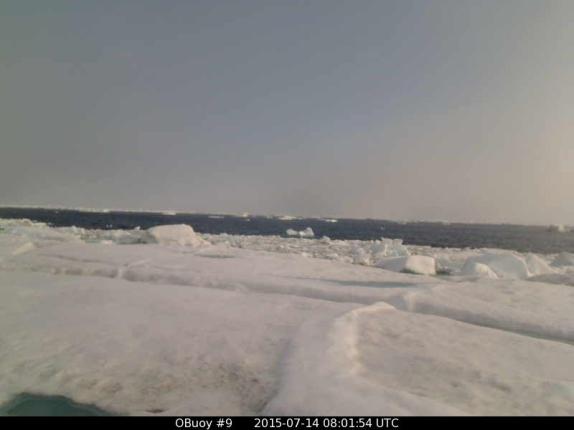 Across the Pole at O-buoy 12 Lake Chukchi remains the same, as temperatures dip below freezing and winds remain light.
Across the Pole at O-buoy 12 Lake Chukchi remains the same, as temperatures dip below freezing and winds remain light.  It is breezier at O-buoy 11, with winds over 10 mph, and temperatures dipping back to freezing after a period of thaw. The lead is opening to the right while it seems to have slammed shut to the left. This sort of twisting can break up the ice, I’ve seen in the past, but as it hasn’t happened yet I’ll have to sort of cheat to get a headline out of this picture.
It is breezier at O-buoy 11, with winds over 10 mph, and temperatures dipping back to freezing after a period of thaw. The lead is opening to the right while it seems to have slammed shut to the left. This sort of twisting can break up the ice, I’ve seen in the past, but as it hasn’t happened yet I’ll have to sort of cheat to get a headline out of this picture.
PHOTO OF HUGE SEA-LEVEL RISE IN BEAUFORT SEA!!!
It is perfectly obvious a huge wave is moving in from the right left and if you deny it you are a denier. The only way to stop this wave, and keep it from smashing in your front door, is to hurry out today and buy curly light bulbs.
 TUESDAY NIGHT UPDATE —Relentless, Merciless Sunshine—
TUESDAY NIGHT UPDATE —Relentless, Merciless Sunshine—
Faboo benignly rafted tragically limped another 2.34 miles south-southwest, winding up at 86.557°N, 4.392°W. The beautiful, beneficent relentless, merciless sunshine continued to bathe pound the sea-ice with summer’s typical gentle thaws horrible proof of the planet’s destruction. Here are some pictures from Faboo’s serene nerve-shattering day.
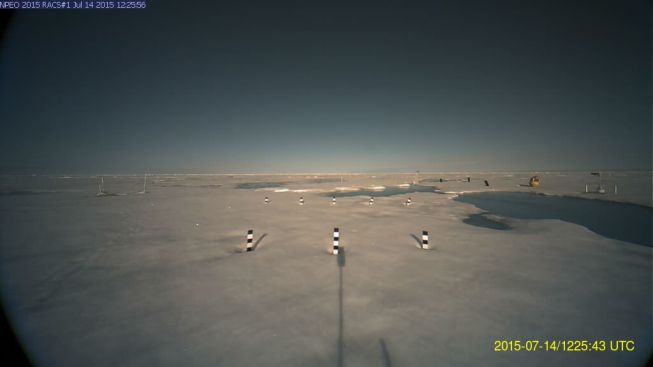

 I’m worn out, so I’m just going to post the DMI maps, hand this report over to the Global Warming Editor for editing, and hit the hay.
I’m worn out, so I’m just going to post the DMI maps, hand this report over to the Global Warming Editor for editing, and hit the hay.
WEDNESDAY MORNING UPDATE
The morning maps continue to show high pressure over the Pole and low pressure over the Eurasian though the high pressure is starting to be pressed to the Atlantic side, as low pressure works across Bering Strait to Alaska.
The low pressure intensifying over Kara Sea, (which I suppose is a reincarnation of Baltzipson), is accenting the area, basically Finland into West Siberia, that has had a very cool summer.
The Pacific to Atlantic flow has pressed past the Pole and may start to move Faboo a little faster soon. Currently Faboo is taking its sweet time, and is far north of where we were at this time last year, when our North Pole Camera was about to be crunched just north of Svalbard.
Currently Faboo is taking its sweet time, and is far north of where we were at this time last year, when our North Pole Camera was about to be crunched just north of Svalbard. Interestingly, though there is visible melt atop the ice, and indeed Faboo sits in its own self-made melt-water pool, the melt beneath the ice from the bottom up hasn’t started much, yet. Is the water especially cold in this part of the Arctic Sea?
Interestingly, though there is visible melt atop the ice, and indeed Faboo sits in its own self-made melt-water pool, the melt beneath the ice from the bottom up hasn’t started much, yet. Is the water especially cold in this part of the Arctic Sea?
 Sadly, the O-buoy cameras aren’t reporting this morning.
Sadly, the O-buoy cameras aren’t reporting this morning.
The Mass balance buoys report general thaw, with only two buoys, 2015B and 2014F reporting a hair below freezing, reporting -0.09°C and -0.03°C respectively.
2015A is drifting northwest along the coast of Alaska, and has moved far enough from the coast that we aren’t getting the really warm temperatures from off the sun-baked tundra any more. It’s coming in at +0.53°C at noontime, when it would be reading +7.00°C a couple weeks ago. You have to take such things into account, for some times cooling is due to a cold air mass, and sometimes due to a buoy drifting away from land.
High pressure is hanging on at the Pole, as low pressure plays ring around the Rosie, for a while longer, though there are changes in the air, especially with cold air and low pressure home-brewing over by Bering Strait. The stable pattern is starting to wobble a bit, and some models see a low, a secondary of Lagzipson that now sits over the Kara Sea, come shooting up from the south and right across the Pole to Canada, around a week from now. In the meantime the high pressure towards Greenland and low pressure towards the Kara Sea will push the sea-ice towards the Atlantic.
Faboo saw the calm end and light breezes spring up, immediately dropping temperatures a degree. The day’s high was +1.4°C at noon and the low was +1.0°C at 2100Z at both ends of the measuring period. The light breezes up near 10 mph meant we moved more, 5.59 miles south-southwest to 86.478°N, 4.694°W. The view seemed to show a change in the weather threatening from Eurasia.
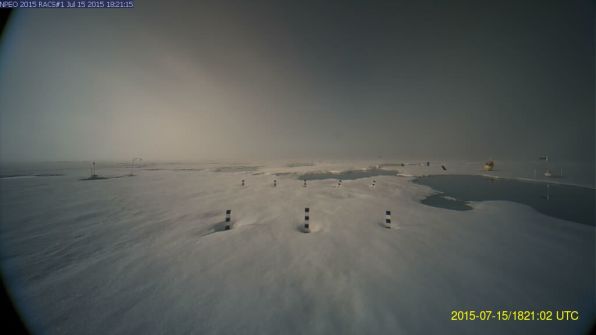 The O-buoys still aren’t reporting, which irks me as O-buoy 9 has been so fascinating.
The O-buoys still aren’t reporting, which irks me as O-buoy 9 has been so fascinating.
Have to run. Sizzling meat on a barbecue is calling me. Sometimes sea-ice comes second.
O-BUOYS UP AND RUNNING AGAIN
O-buoy 9 still survives, now drifting back to the west and south. Winds around 6 mph. Air temperatures just above freezing. Slush in the water shows the water is very cold.  At O-buoy 11 the tilt goes on. A foot of the surface has melted away, and a foot of the bottom of the ice as well. Remaining ice is roughly 4 feet thick. Temperature at freezing, with light airs at 2 mph.
At O-buoy 11 the tilt goes on. A foot of the surface has melted away, and a foot of the bottom of the ice as well. Remaining ice is roughly 4 feet thick. Temperature at freezing, with light airs at 2 mph.
 O-buoy 12 has temperatures at freezing with winds around 6 mph.
O-buoy 12 has temperatures at freezing with winds around 6 mph.  As a side note, the grubby bottom of Lake Chukchi is not necessarily caused by man-made soot or the erupted ash from volcanoes. Much may be locally grown micro creatures, various slimes and germs that thrive in bizarre habitats, including sub-freezing brine and the bottom of sea-ice lit from above. Over time they, or their microscopic corpses, can make ice appear dirty.
As a side note, the grubby bottom of Lake Chukchi is not necessarily caused by man-made soot or the erupted ash from volcanoes. Much may be locally grown micro creatures, various slimes and germs that thrive in bizarre habitats, including sub-freezing brine and the bottom of sea-ice lit from above. Over time they, or their microscopic corpses, can make ice appear dirty.
THURSDAY MORNING UPDATE
It looks calm and mild at the Pole this morning, with all the action over towards Eurasia. All the sub-freezing air looks to be south of 80° latitude, so expect the DMI north-of-80° graph to spoke above normal. Some warmth is trying to push east through the Baltic to the Kara Sea, but from there east it is cold clear around the Arctic Circle to Alaska. Then some warmth is pushing north through central Canada, along the western shore of Hudson Bay, through the Canadian Archipelago, and out towards the Pole. My guess is that warm air will rise and create low pressure, ending the rule of high pressure at the Pole. Continuing east, sub-freezing is seen over ice-covered waters in Baffin Bay and northwest of Svalbard.
Faboo has seen a return of sunshine. Likely winds are dropping, as the high pressure centers over them. Temperatures from the Mass Balance buoy’s unofficial report are at +0.10°C , which is below normal.
 The only report of normal warmth os from Buoy 2015E in Fram Strait, reporting +1.06°, but O-buoy 9 is showing thaw and light winds.
The only report of normal warmth os from Buoy 2015E in Fram Strait, reporting +1.06°, but O-buoy 9 is showing thaw and light winds.  Over towards the Beaufort Sea the only report more than a half degree above is from Buoy 2014I, coming in at +0.88° C.
Over towards the Beaufort Sea the only report more than a half degree above is from Buoy 2014I, coming in at +0.88° C.  The only report of below freezing comes from 2015B in the early afternoon, when temperatures are usually highest, at -0.35° C. North of there 2014G reports +0.30° C, and co-located O-buoy 12 shows Lake Chukchi not rising, but expanding ever so slightly towards the center of the picture by eroding that bank.
The only report of below freezing comes from 2015B in the early afternoon, when temperatures are usually highest, at -0.35° C. North of there 2014G reports +0.30° C, and co-located O-buoy 12 shows Lake Chukchi not rising, but expanding ever so slightly towards the center of the picture by eroding that bank. I’ll be late posting tonight.
I’ll be late posting tonight.
THURSDAY EVENING UPDATE
Faboo drifted another 4.72 miles southwest to 86.422°N, 5.331°W, as winds slowly slacked off from 10 mph to 5 mph. The wildly exciting news for the day was an abrupt wind shift from north to east, accompanied by a nearly two degree drop in temperatures. Temperatures had been roughly a degree above freezing all day, achieving the high of +1.2° C at 1500z, and then at 1800z it was down to -0.2°C. STOP THE PRESSES!!! The final reading at 2100Z yesterday was -0.5°C.
Looking back at the picture from around that time (above) the 1821Z picture did have a bit of gloom in the sky, but things swiftly reverted to the gorgeous weather we’ve lucked into lately, after a very gloomy start to the summer. The only possible sign it may have been a bit colder is that the snow sparkles. Lake Faboo continues to be less than impressive, and is failing to get us proper press coverage.
 To the south-southwest O-buoy 9 has turned back to the southeast in light winds and temperatures just above freezing. We have lost a couple large blocks of ice from the prow of our ship. Perhaps this will be like setting our sails in a different manner, and we will swing around to look behind us, where I think the bluffs of Greenland’s coast lie. As best as I can tell, just calculating from shadows, we are looking northeast, and are just turning the corner at the northeast tip of Greenland.
To the south-southwest O-buoy 9 has turned back to the southeast in light winds and temperatures just above freezing. We have lost a couple large blocks of ice from the prow of our ship. Perhaps this will be like setting our sails in a different manner, and we will swing around to look behind us, where I think the bluffs of Greenland’s coast lie. As best as I can tell, just calculating from shadows, we are looking northeast, and are just turning the corner at the northeast tip of Greenland.  To the south-southeast of there, nearly due south of Faboo, 2015E had made it down to 77.87° N earlier today, yet managed sub-freezing temperatures of -0.10° C in the unofficial Mass Balance reports. It has since bounced back up to +0.57° C.
To the south-southeast of there, nearly due south of Faboo, 2015E had made it down to 77.87° N earlier today, yet managed sub-freezing temperatures of -0.10° C in the unofficial Mass Balance reports. It has since bounced back up to +0.57° C.
Over on the Pacific side things are fairly dull, with nothing noteworthy. Its hard to get headlines when temperatures barely stray a half degree from freezing. But O-buoy 12 has a nice picture this evening. I don’t see much in the maps, but my eyes nay be keener in the morning.
I don’t see much in the maps, but my eyes nay be keener in the morning.

FRIDAY MORNING UPDATE
The maps show high pressure stubborn over the Pole, though now eroded from both the Pacific and Atlantic sides. It remains surprisingly cold just north of Bering Strait, especially with the PDO in a warm phase. An interesting kickback low is retrograding north of Scandinavia, increasing the flow into Fram Strait. It may be spreading ice out like butter over bread, and explain the uptick in the extrent graph, (You can know for sure the sea isn’t freezing up, in July). The only other explanation is that a snowfall towards the Pacific has dusted slush, and areas recorded as “open water” by microwave sensors up in satellites abruptly were seen as “ice.” Faboo continues slowly southwest through fair weather. Lake Faboo is staying the same size despite constant sunshine and thawing temperatures.
Faboo continues slowly southwest through fair weather. Lake Faboo is staying the same size despite constant sunshine and thawing temperatures.
 With the Pole sunny and thawing, and sub-freezing temperatures all shunted south of 80°, the DMI temperatures-north-of-80° shows the first midsummer above-normal temperatures in three years.
With the Pole sunny and thawing, and sub-freezing temperatures all shunted south of 80°, the DMI temperatures-north-of-80° shows the first midsummer above-normal temperatures in three years.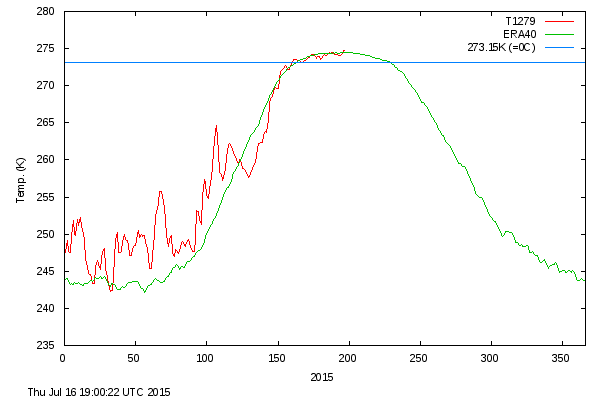 If you are an Alarmist you should focus on this graph and ignore the extent graph, but if you are a Skeptic seize the extent graph. In truth the midsummer weather is normal, and rather boring, which is how I like it.
If you are an Alarmist you should focus on this graph and ignore the extent graph, but if you are a Skeptic seize the extent graph. In truth the midsummer weather is normal, and rather boring, which is how I like it.
O-buoy 9’s camera may be in the drink, as there are no pictures this morning.
I have a busy day ahead, and may be posting late again this evening.
BRIEF EVENING UPDATE
O-buoys not reporting, which is what I check first, as mostly nothing happens when you sit about watching ice melt, but something was always happening out the window of O-buoy 9, but I fear it may be sunk.
Faboo is reporting the same old dull drift southwest, though it did pause and then move east, after reaching 5.471°W at noon. (Whoopdedo.) We wound up at 86.398°N, 5.458°W, which is a whopping 1.74 miles in the last 24 hours. At this rate we’ll get to Fram Strait sometime next year. It gives a totally false impression of how active the Arctic Sea actually is. Only during the summer does ice sit about like this. The pity is that during the winter, when things get wild, it is pitch dark and the cameras can’t see.
Faboo also reports temperatures gradually creeping up from freezing to +1.2°C at noon yesterday, and then falling back to +0.2°C at 2100Z, but there was time when the winds got completely calm, and the buoy baked in the sun and created an air-cocoon of warmth around itself, and then the temperatures spiked up to +3.6°C at 1800Z. This data likely should be tossed out, but considering they use data from over the hot tarmac of airports in the exhaust of jumbo-jets, and then “adjust” it up a bit, I doubt they’ll throw this daytime high out.
The DMI maps show the high eroding away, over the Pole, and the chill persisting over towards Bering Strait.
SATURDAY UPDATE —Faboo Stands Alone—
This will be a little like the old days, as both the O-buoy site and the Mass Balance Site seem to be taking a well-earned weekend off, and all we have is Faboo. I’ve been a bit spoiled through having so many cameras to look at. Back in the day, there was only one.
Faboo has remained tucked in the calm center of high pressure, and the ice is moving faster than the wind, when the wind is calm (obviously.) It demonstrates the bulk and magnitude of the Trans Polar Drift. At time the ice is pushed along by other ice which is pushed by other ice, and the power may be winds hundreds of miles away.
Our winds were never higher than the 1 m/s range, which is a draft of around 2 mph. I was expecting to see the usual heat-island effect, but even a light draft can drop temperatures. For example, on Thursday we saw winds calm and a reading of +3.6°C, and the next reading, with winds only 2 mph, saw a drop to +0.2°. (Readings in these official reports are three hours apart. Also they are a day late, so today’s report involves Friday’s temperatures.) Friday’s low got below freezing when the midnight sun dipped down to its lowest, and were at -0.2°C at 0300z. Then they began the typical slight diurnal rise you notice even though the sun never sets, and because the wind never stopped entirely I likely should not suspect any heat-island effect when we arrive at our high at noon of +2.3°C, (but of course I do, being a suspicious fellow, and noticing Faboo has melted its private pool to sit in.) Then temperatures were in their slight diurnal slump, when the wind did die for the final report at 2100, and the temperature obligingly jumped from +1.7°C to +2.7°C, verifying my pet theory about the heat-island. This is a big event for me, for usually I have to confess my theories have just been proven wrong. Faboo does keep a man humble.
With the winds so light we only traveled 1.52 miles to 86.376°N, 5.454°W. There were some interesting giggles east and west as we crawled south, as far east as 5.452°W at midnight, and as far west as 5.483°W at noon, and then back east to 5.452°W again at 1800z, before we shifted back .002° at our final reading.
It should be noted that at this latitude a full degree of longitude is only 4.36 miles, so when you are talking about a thousandth of a degree longitude you are talking about 4 thousandth of a mile. You can spit that distance.
Often when winds are calm, we get our prettiest pictures. 
 (Click to enlarge, or open to new tabs to compare.)
(Click to enlarge, or open to new tabs to compare.)
Lake Faboo is no deeper, but is melting away at its sides, and a small ice island in it has all but melted away completely.
DMI maps show the high pressure starting to again expand over the Pole. The models were showing a low moving up over the Pole from the Kara Sea, but they have dropped that idea. Now it looks like the high will move back and rule the Pole. The sub-freezing air continues to hang around over towards the Pacific side. If this keeps up it may make one of my predictions wrong. I predicted a lot of melting on that side, due to the warmth of the PDO, but, even though most of the melting comes from underneath, sub-freezing temperatures can’t hurry things along any.
As this post is getting lengthy, I’ll think I’ll wrap it up, and spend some time trying to think up a witty title for the next one.











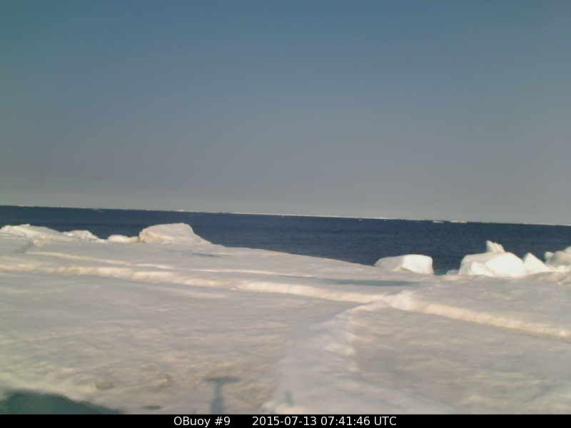












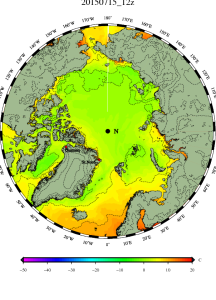

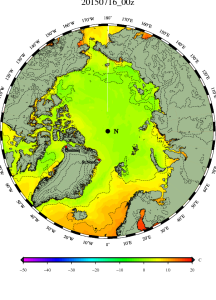






The arctic basin appears to be remarkably quiet (at least to my untrained eye) and while off your maps the jet stream over the Pacific and the Atlantic looks robust and of a definite zonal nature. What it means … who knows?
I’m enjoying your arctic armchair ramblings 😉
Caleb … were you looking for permeable and impermeable? Careful with the limestone / sandstone example since both can be porous or tight / nonporous. Re the porosity / permeability thing, take it from an old geologist that porosity is the holes in the material (rock in my career) and the permeability is how well those holes are connected to each other. The shale oil and gas now being developed is all about creating some effective permeability by hydraulicly fracing the rock.